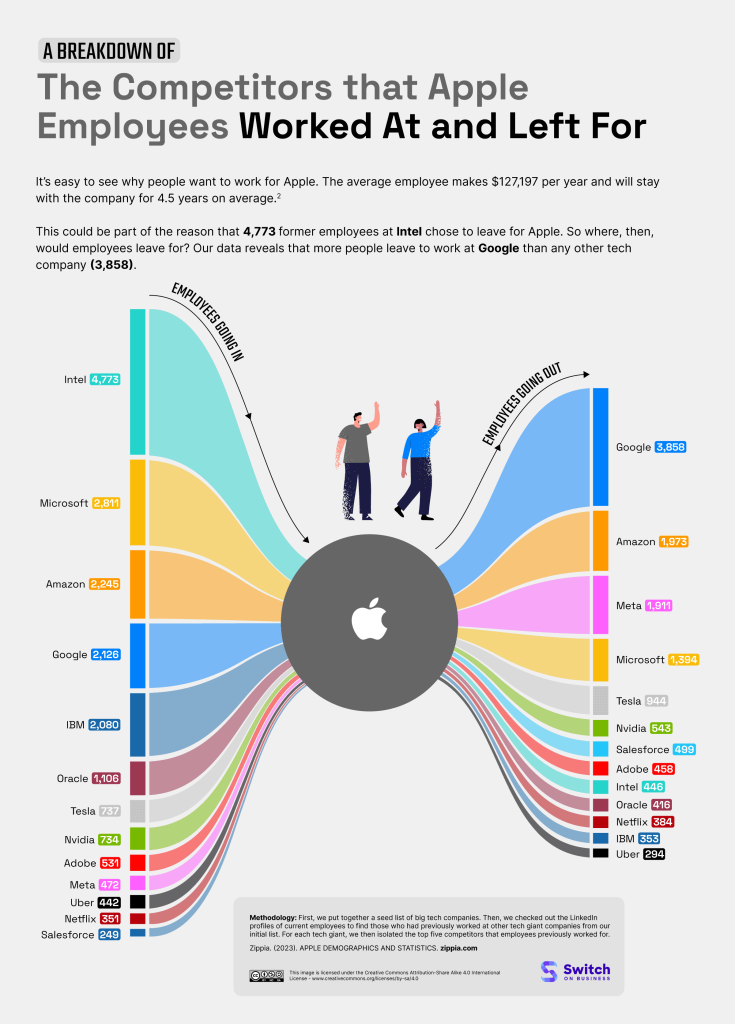When it comes to the tech industry, talent flows between companies like currents in a vast digital ocean. Recently, an illuminating analysis conducted by Switch on Business provided a snapshot of these career currents by examining LinkedIn profiles to determine where former Apple employees tend to migrate within the tech sector.
The Journey to and from Apple

Through a thorough exploration of LinkedIn profiles, Switch on Business uncovered intriguing patterns of employment movement among tech giants. The study looked at a selection of prestigious companies: Google (Alphabet), Amazon, Apple, Meta, Microsoft, IBM, Tesla, Oracle, Netflix, Nvidia, Salesforce, Adobe, Intel, and Uber. The investigation sought to identify how many individuals were currently employed at these powerhouses and had worked for another company on the list.
The analysis showed that Apple has a history of attracting talent from several leading firms, most notably Intel, Microsoft, and Amazon. Apple’s substantial recruitment from Intel isn’t surprising, given Apple’s acquisition of Intel’s smartphone modem business in 2019 for one billion dollars. This strategic move, which aimed to bolster Apple’s capacity to design its own radio chips, led to a significant intake of former Intel employees.
The Preferred Destination: Google Leads the Pack
On the flip side, when employees decide to part ways with Apple, they are more inclined to segue into Google’s workforce than anywhere else. In fact, the exodus to Google was almost double that of the next popular destination for ex-Apple personnel, Amazon. This highlights the allure of Google as a workplace in the eyes of Apple’s outgoing talent.
Contrasting Recruitment Strategies

Apart from these inter-company movements, what stands out from the study is Apple’s relatively modest hiring from other tech giants, which is a mere 5.7% of its workforce. This is quite the contrast when compared to Meta’s 26.5%, Google’s 25.1%, and Salesforce’s 20.7%. Such figures suggest a more insular recruitment strategy on the part of Apple or possibly a greater reliance on cultivating talent internally or sourcing from different industries and smaller companies.
Implications for the Tech Industry
Understanding these employment trends is invaluable for industry watchers and those within the tech world. It not only mirrors the strategic partnerships and competitions at play but also reflects the dynamic nature of career paths in tech. For those considering a jump, whether into or out of Apple, familiarity with these trends could influence decisions on the next big career move.
Moreover, they highlight the interconnectedness of the tech industry’s employment landscape — a tightly woven network where today’s competitor can be tomorrow’s collaborator. It’s a testament to the fluidity and the constant quest for innovation that define the technology sector, illustrating that movement of talent is as much part of the business as code and hardware.
For more details on the full scope of talent movement across the tech giants, you can delve deeper into Switch on Business’ comprehensive analysis, which offers a rich dataset for those inclined to resist speculations and rely on hard numbers. No matter how you slice the data, one thing is clear: the tech industry’s appetite for top talent is as voracious as ever.



